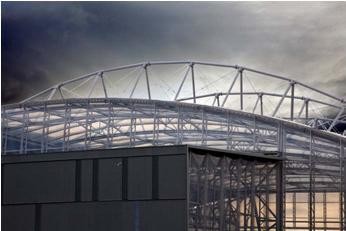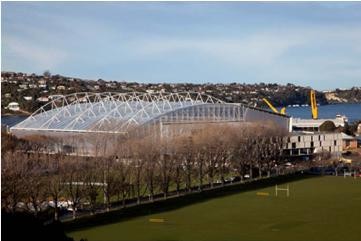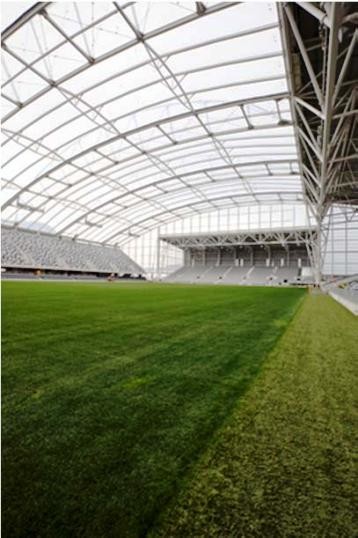The world’s first permanently enclosed, natural turf stadium has been completed in New Zealand in Forsyth Barr stadium in Dunedin.
Architecture firm Populous designed the stadium in association with local firm Jasmax to replace the famous Carisbrook House of Pain.
The first game of rugby will be held under what has been termed the “space age transparent roof” on August 7.
Construction of the stadium with 20,000 permanent and 11,000 temporary seats has been completed on time and on budget, ahead of the World Cup tournament.
The unique roof is the result of extensive research by the design team. While ETFE (ethylene tetrafluoroethylene) is not a new product and was originally developed for the space industry, it is the first time its UV translucent properties have been put to use in a stadium, creating the largest ETFE covered structure in the Southern Hemisphere.
 Populous senior principal and project director of Forsyth Barr stadium, Richard Breslin, said the design provides the multifunctionality and flexibility so it is positioned to be used by its community all year round.
Populous senior principal and project director of Forsyth Barr stadium, Richard Breslin, said the design provides the multifunctionality and flexibility so it is positioned to be used by its community all year round.
“Research by many people has created this final concept of a natural grass pitch growing under a permanent roof structure .
“The unique permanent roof is clad in EFTE, a transparent polymer or plastic, which is light, enclosed and translucent, allowing maximum sunlight onto the pitch, so that the grass keeps growing but the fans are protected from the elements and the action goes on whatever the weather.
“The permanent roof means Forsyth Barr is a true hybrid between a highly efficient, well functioning football/rugby stadium and an entertainment venue,” said Breslin.
The stadium will also be New Zealand’s largest indoor event venue — it will host the singer songwriter Elton John, when he stages the first concert at the stadium in November this year.
 The rectangular design will also change the way we view the live game in New Zealand according to Breslin.
The rectangular design will also change the way we view the live game in New Zealand according to Breslin.
“The angled seating pitch and enclosed roof will mean spectators are closer to the action than ever before and the atmosphere will be fantastic. I was there recently, and even though there was no game on, the sense of enclosure made the hairs stand up on the back of my neck. I could almost hear the noise, and the smell and feel of the atmosphere of the rival teams during that first big rugby match,” he said.
Populous associate principal, Ron Van Sluijs, project architect of Forsyth Barr stadium during its design phase, said: “The new roof means we can maintain a constant temperature and grow a stronger grass which will not become boggy because it will never rain, snow, or hail inside the stadium during a game at Forsyth Barr.
“This roof material allows for 90 per cent of sunlight to still reach the pitch, along with UV light and fresh air.”
Another project architect, Jochem Veerman, said the sectional profile of the stadium was carefully designed to maximise solar penetration onto the field as well as the natural ventilation.
“The ETFE covers the roof and parts of the facades, the stands on the Northern end are lower to allow maximum sun light onto the pitch and the end facades are raised five metres so the stadium is open at these points, allowing natural ventilation of the grass, and to ensure spectators do not feel enclosed. There are also ventilation slots at a high level to ensure air circulates properly,” he said.

